Report on FNB's Social Media Strategy: Customer Engagement and Growth
VerifiedAdded on 2020/05/28
|5
|1382
|142
Report
AI Summary
This report provides a comprehensive analysis of First National Bank (FNB)'s social media strategy. It examines how FNB, one of South Africa's 'Big Four' banks, leverages platforms like Facebook, Twitter, and LinkedIn to enhance customer engagement, improve customer service, and build its brand. The report details the implementation of the eWallet product through a Facebook game and the use of Twitter for customer relationship management. It highlights the benefits of FNB's approach, including increased customer confidence, improved brand image, and the ability to understand customer needs. The report also discusses the lessons learned from FNB's strategy, such as the importance of adapting to technological changes and maintaining a strong digital presence in a competitive market. It emphasizes the importance of analyzing customer feedback, responding to queries promptly, and making customers feel valued. The analysis concludes that FNB's social media strategy has significantly contributed to its market competitiveness, fostering better communication and transparency with its stakeholders.
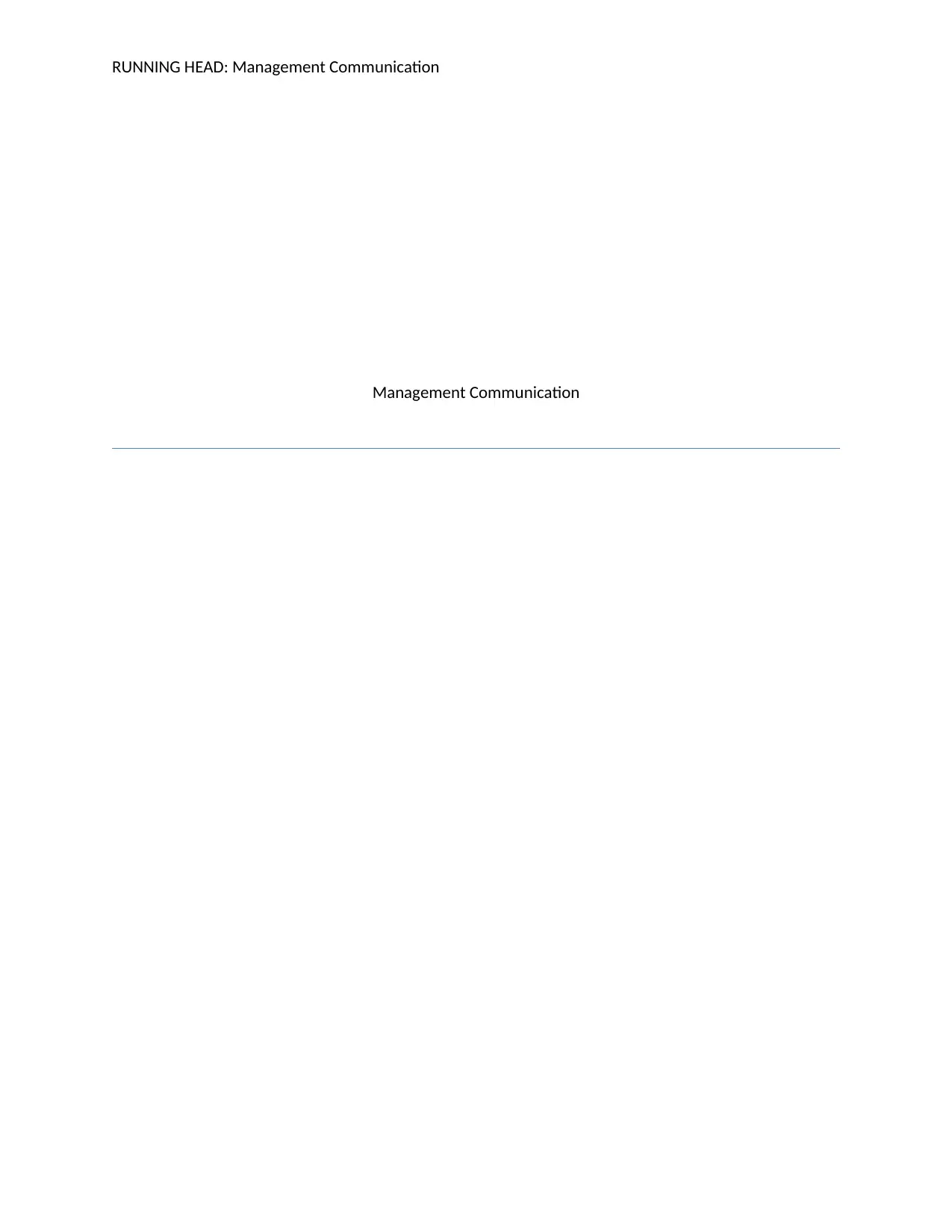
RUNNING HEAD: Management Communication
Management Communication
Management Communication
Paraphrase This Document
Need a fresh take? Get an instant paraphrase of this document with our AI Paraphraser
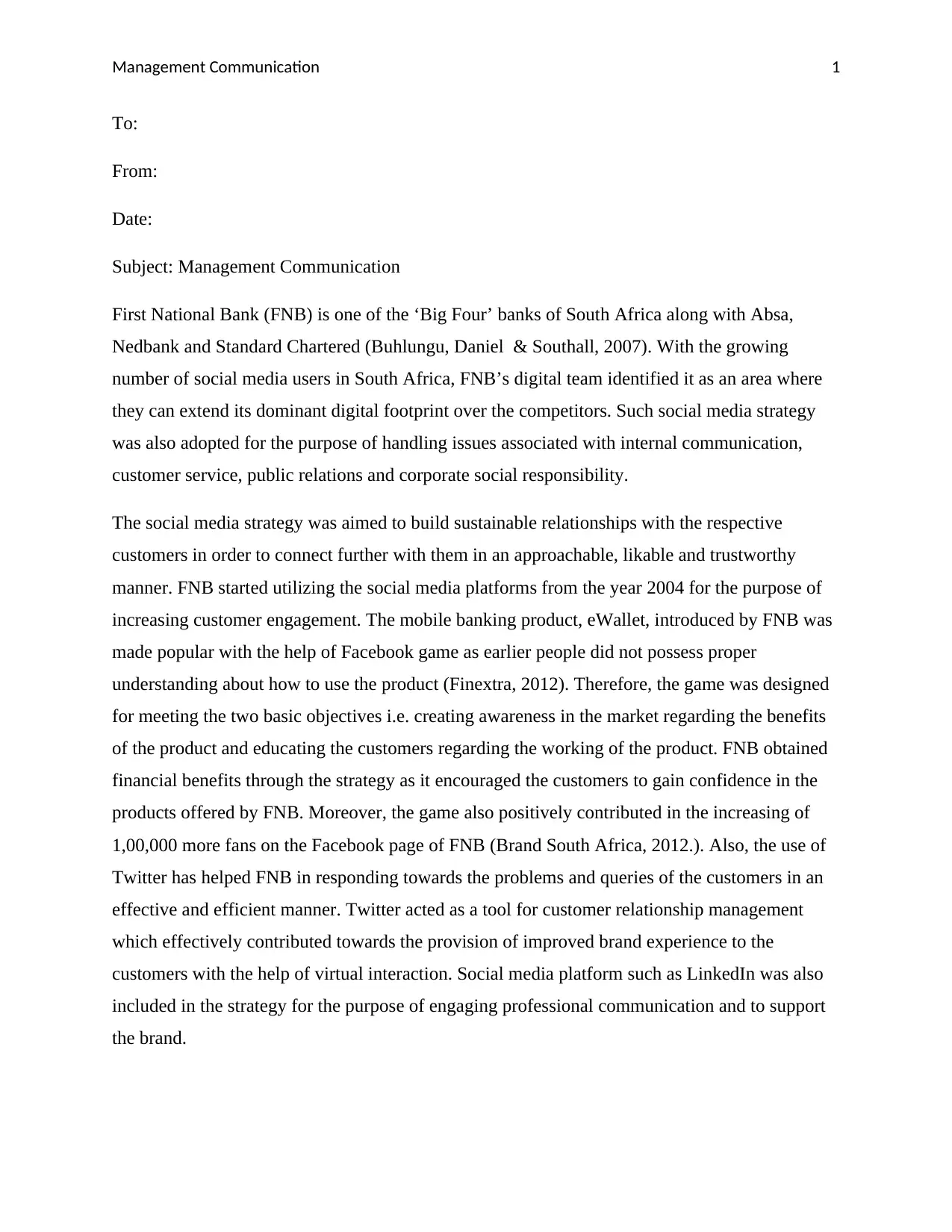
Management Communication 1
To:
From:
Date:
Subject: Management Communication
First National Bank (FNB) is one of the ‘Big Four’ banks of South Africa along with Absa,
Nedbank and Standard Chartered (Buhlungu, Daniel & Southall, 2007). With the growing
number of social media users in South Africa, FNB’s digital team identified it as an area where
they can extend its dominant digital footprint over the competitors. Such social media strategy
was also adopted for the purpose of handling issues associated with internal communication,
customer service, public relations and corporate social responsibility.
The social media strategy was aimed to build sustainable relationships with the respective
customers in order to connect further with them in an approachable, likable and trustworthy
manner. FNB started utilizing the social media platforms from the year 2004 for the purpose of
increasing customer engagement. The mobile banking product, eWallet, introduced by FNB was
made popular with the help of Facebook game as earlier people did not possess proper
understanding about how to use the product (Finextra, 2012). Therefore, the game was designed
for meeting the two basic objectives i.e. creating awareness in the market regarding the benefits
of the product and educating the customers regarding the working of the product. FNB obtained
financial benefits through the strategy as it encouraged the customers to gain confidence in the
products offered by FNB. Moreover, the game also positively contributed in the increasing of
1,00,000 more fans on the Facebook page of FNB (Brand South Africa, 2012.). Also, the use of
Twitter has helped FNB in responding towards the problems and queries of the customers in an
effective and efficient manner. Twitter acted as a tool for customer relationship management
which effectively contributed towards the provision of improved brand experience to the
customers with the help of virtual interaction. Social media platform such as LinkedIn was also
included in the strategy for the purpose of engaging professional communication and to support
the brand.
To:
From:
Date:
Subject: Management Communication
First National Bank (FNB) is one of the ‘Big Four’ banks of South Africa along with Absa,
Nedbank and Standard Chartered (Buhlungu, Daniel & Southall, 2007). With the growing
number of social media users in South Africa, FNB’s digital team identified it as an area where
they can extend its dominant digital footprint over the competitors. Such social media strategy
was also adopted for the purpose of handling issues associated with internal communication,
customer service, public relations and corporate social responsibility.
The social media strategy was aimed to build sustainable relationships with the respective
customers in order to connect further with them in an approachable, likable and trustworthy
manner. FNB started utilizing the social media platforms from the year 2004 for the purpose of
increasing customer engagement. The mobile banking product, eWallet, introduced by FNB was
made popular with the help of Facebook game as earlier people did not possess proper
understanding about how to use the product (Finextra, 2012). Therefore, the game was designed
for meeting the two basic objectives i.e. creating awareness in the market regarding the benefits
of the product and educating the customers regarding the working of the product. FNB obtained
financial benefits through the strategy as it encouraged the customers to gain confidence in the
products offered by FNB. Moreover, the game also positively contributed in the increasing of
1,00,000 more fans on the Facebook page of FNB (Brand South Africa, 2012.). Also, the use of
Twitter has helped FNB in responding towards the problems and queries of the customers in an
effective and efficient manner. Twitter acted as a tool for customer relationship management
which effectively contributed towards the provision of improved brand experience to the
customers with the help of virtual interaction. Social media platform such as LinkedIn was also
included in the strategy for the purpose of engaging professional communication and to support
the brand.
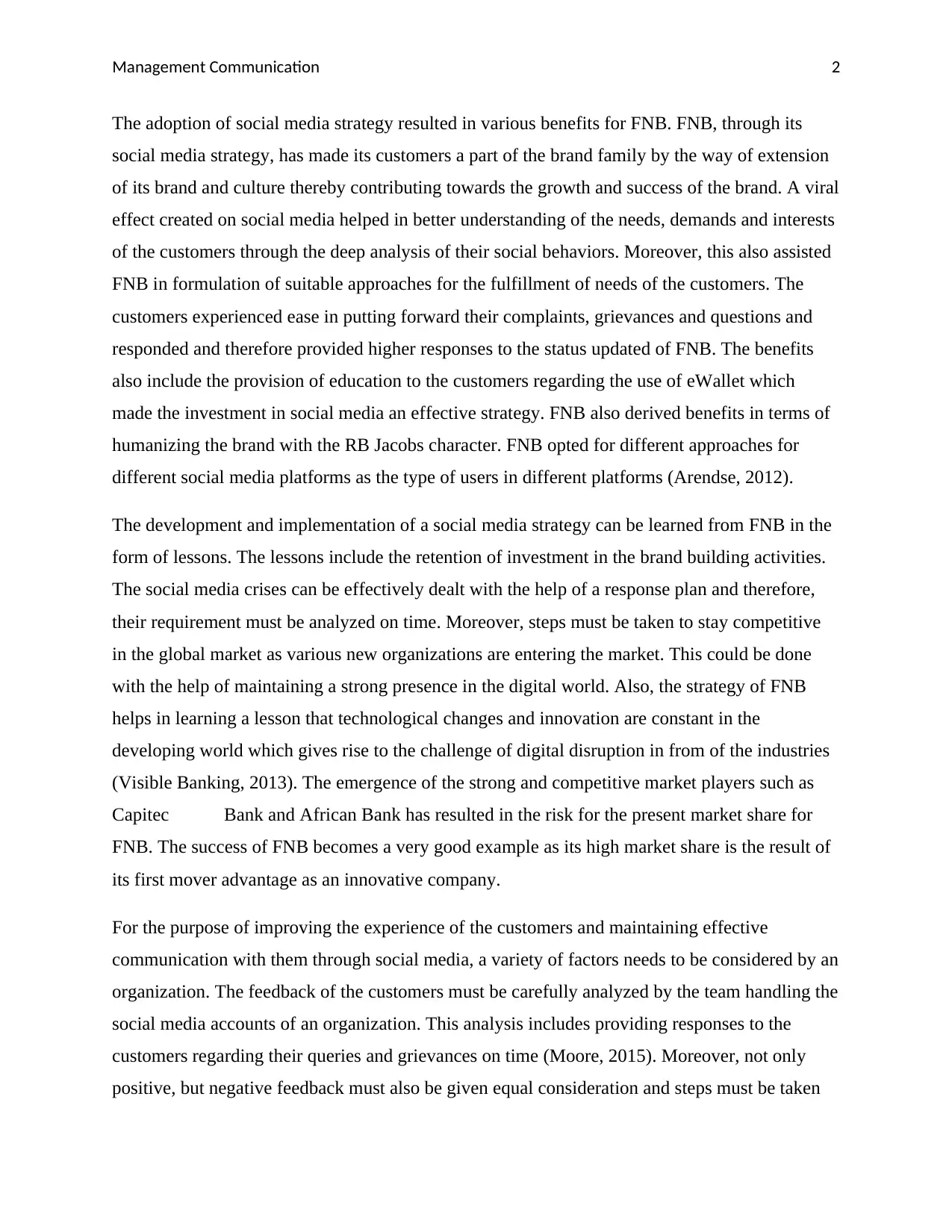
Management Communication 2
The adoption of social media strategy resulted in various benefits for FNB. FNB, through its
social media strategy, has made its customers a part of the brand family by the way of extension
of its brand and culture thereby contributing towards the growth and success of the brand. A viral
effect created on social media helped in better understanding of the needs, demands and interests
of the customers through the deep analysis of their social behaviors. Moreover, this also assisted
FNB in formulation of suitable approaches for the fulfillment of needs of the customers. The
customers experienced ease in putting forward their complaints, grievances and questions and
responded and therefore provided higher responses to the status updated of FNB. The benefits
also include the provision of education to the customers regarding the use of eWallet which
made the investment in social media an effective strategy. FNB also derived benefits in terms of
humanizing the brand with the RB Jacobs character. FNB opted for different approaches for
different social media platforms as the type of users in different platforms (Arendse, 2012).
The development and implementation of a social media strategy can be learned from FNB in the
form of lessons. The lessons include the retention of investment in the brand building activities.
The social media crises can be effectively dealt with the help of a response plan and therefore,
their requirement must be analyzed on time. Moreover, steps must be taken to stay competitive
in the global market as various new organizations are entering the market. This could be done
with the help of maintaining a strong presence in the digital world. Also, the strategy of FNB
helps in learning a lesson that technological changes and innovation are constant in the
developing world which gives rise to the challenge of digital disruption in from of the industries
(Visible Banking, 2013). The emergence of the strong and competitive market players such as
Capitec Bank and African Bank has resulted in the risk for the present market share for
FNB. The success of FNB becomes a very good example as its high market share is the result of
its first mover advantage as an innovative company.
For the purpose of improving the experience of the customers and maintaining effective
communication with them through social media, a variety of factors needs to be considered by an
organization. The feedback of the customers must be carefully analyzed by the team handling the
social media accounts of an organization. This analysis includes providing responses to the
customers regarding their queries and grievances on time (Moore, 2015). Moreover, not only
positive, but negative feedback must also be given equal consideration and steps must be taken
The adoption of social media strategy resulted in various benefits for FNB. FNB, through its
social media strategy, has made its customers a part of the brand family by the way of extension
of its brand and culture thereby contributing towards the growth and success of the brand. A viral
effect created on social media helped in better understanding of the needs, demands and interests
of the customers through the deep analysis of their social behaviors. Moreover, this also assisted
FNB in formulation of suitable approaches for the fulfillment of needs of the customers. The
customers experienced ease in putting forward their complaints, grievances and questions and
responded and therefore provided higher responses to the status updated of FNB. The benefits
also include the provision of education to the customers regarding the use of eWallet which
made the investment in social media an effective strategy. FNB also derived benefits in terms of
humanizing the brand with the RB Jacobs character. FNB opted for different approaches for
different social media platforms as the type of users in different platforms (Arendse, 2012).
The development and implementation of a social media strategy can be learned from FNB in the
form of lessons. The lessons include the retention of investment in the brand building activities.
The social media crises can be effectively dealt with the help of a response plan and therefore,
their requirement must be analyzed on time. Moreover, steps must be taken to stay competitive
in the global market as various new organizations are entering the market. This could be done
with the help of maintaining a strong presence in the digital world. Also, the strategy of FNB
helps in learning a lesson that technological changes and innovation are constant in the
developing world which gives rise to the challenge of digital disruption in from of the industries
(Visible Banking, 2013). The emergence of the strong and competitive market players such as
Capitec Bank and African Bank has resulted in the risk for the present market share for
FNB. The success of FNB becomes a very good example as its high market share is the result of
its first mover advantage as an innovative company.
For the purpose of improving the experience of the customers and maintaining effective
communication with them through social media, a variety of factors needs to be considered by an
organization. The feedback of the customers must be carefully analyzed by the team handling the
social media accounts of an organization. This analysis includes providing responses to the
customers regarding their queries and grievances on time (Moore, 2015). Moreover, not only
positive, but negative feedback must also be given equal consideration and steps must be taken
⊘ This is a preview!⊘
Do you want full access?
Subscribe today to unlock all pages.

Trusted by 1+ million students worldwide
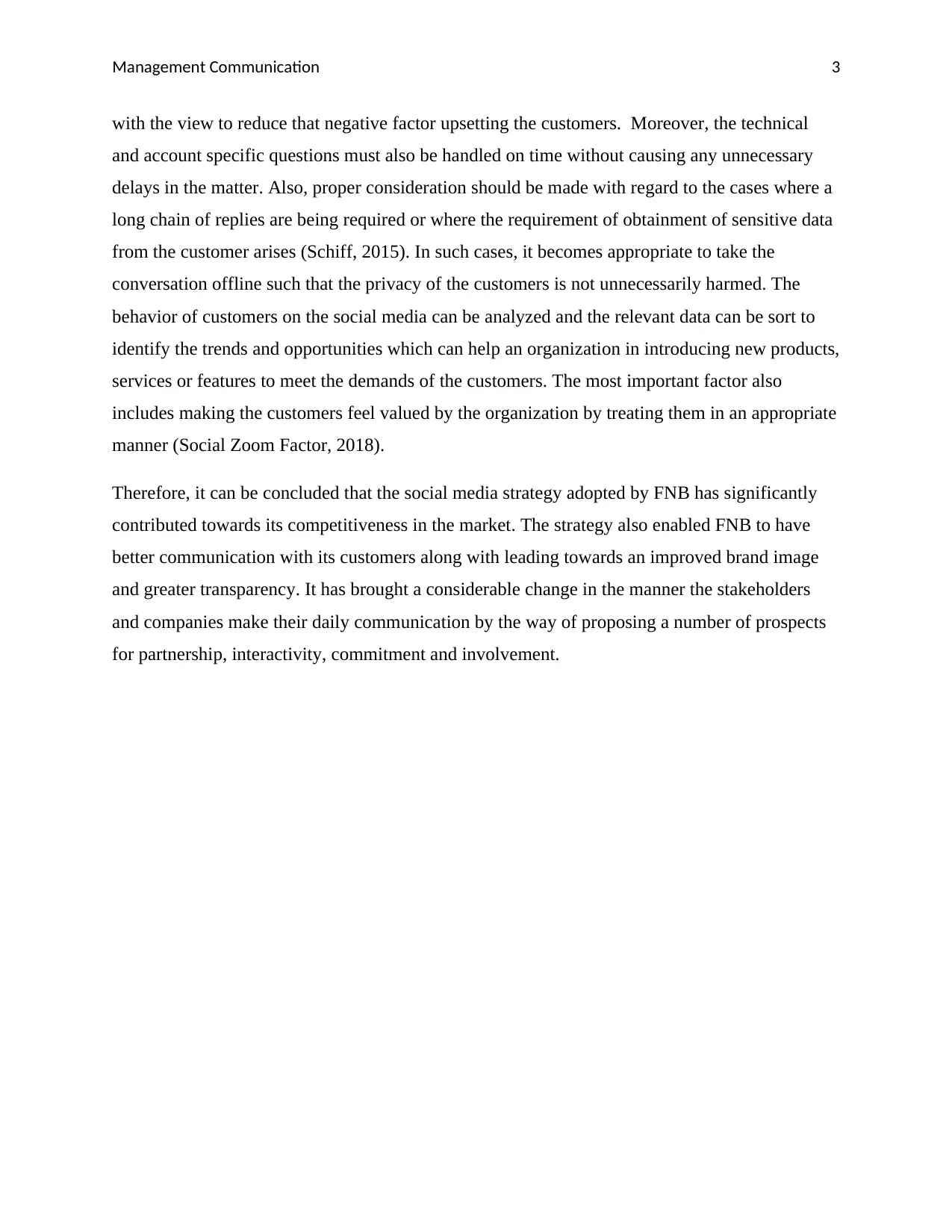
Management Communication 3
with the view to reduce that negative factor upsetting the customers. Moreover, the technical
and account specific questions must also be handled on time without causing any unnecessary
delays in the matter. Also, proper consideration should be made with regard to the cases where a
long chain of replies are being required or where the requirement of obtainment of sensitive data
from the customer arises (Schiff, 2015). In such cases, it becomes appropriate to take the
conversation offline such that the privacy of the customers is not unnecessarily harmed. The
behavior of customers on the social media can be analyzed and the relevant data can be sort to
identify the trends and opportunities which can help an organization in introducing new products,
services or features to meet the demands of the customers. The most important factor also
includes making the customers feel valued by the organization by treating them in an appropriate
manner (Social Zoom Factor, 2018).
Therefore, it can be concluded that the social media strategy adopted by FNB has significantly
contributed towards its competitiveness in the market. The strategy also enabled FNB to have
better communication with its customers along with leading towards an improved brand image
and greater transparency. It has brought a considerable change in the manner the stakeholders
and companies make their daily communication by the way of proposing a number of prospects
for partnership, interactivity, commitment and involvement.
with the view to reduce that negative factor upsetting the customers. Moreover, the technical
and account specific questions must also be handled on time without causing any unnecessary
delays in the matter. Also, proper consideration should be made with regard to the cases where a
long chain of replies are being required or where the requirement of obtainment of sensitive data
from the customer arises (Schiff, 2015). In such cases, it becomes appropriate to take the
conversation offline such that the privacy of the customers is not unnecessarily harmed. The
behavior of customers on the social media can be analyzed and the relevant data can be sort to
identify the trends and opportunities which can help an organization in introducing new products,
services or features to meet the demands of the customers. The most important factor also
includes making the customers feel valued by the organization by treating them in an appropriate
manner (Social Zoom Factor, 2018).
Therefore, it can be concluded that the social media strategy adopted by FNB has significantly
contributed towards its competitiveness in the market. The strategy also enabled FNB to have
better communication with its customers along with leading towards an improved brand image
and greater transparency. It has brought a considerable change in the manner the stakeholders
and companies make their daily communication by the way of proposing a number of prospects
for partnership, interactivity, commitment and involvement.
Paraphrase This Document
Need a fresh take? Get an instant paraphrase of this document with our AI Paraphraser
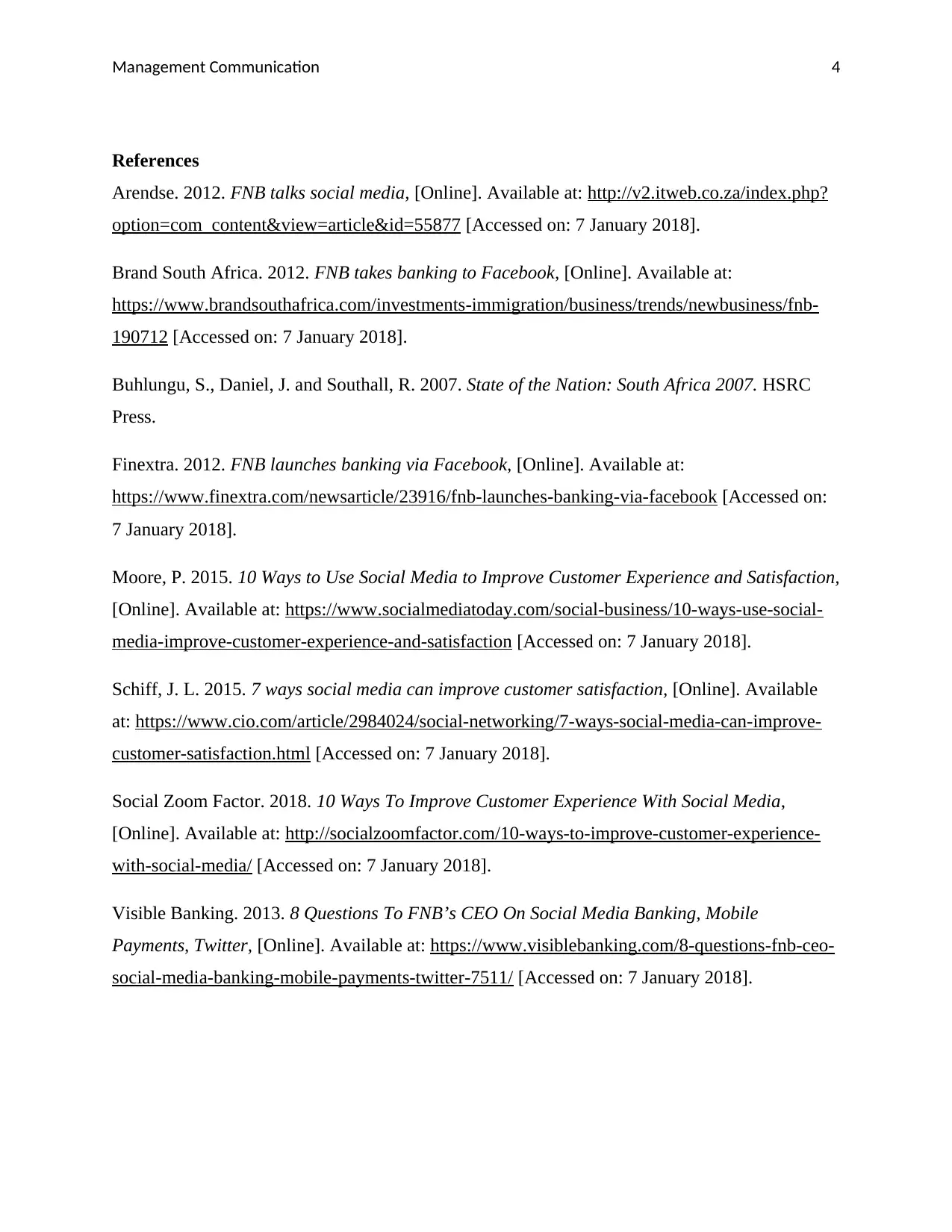
Management Communication 4
References
Arendse. 2012. FNB talks social media, [Online]. Available at: http://v2.itweb.co.za/index.php?
option=com_content&view=article&id=55877 [Accessed on: 7 January 2018].
Brand South Africa. 2012. FNB takes banking to Facebook, [Online]. Available at:
https://www.brandsouthafrica.com/investments-immigration/business/trends/newbusiness/fnb-
190712 [Accessed on: 7 January 2018].
Buhlungu, S., Daniel, J. and Southall, R. 2007. State of the Nation: South Africa 2007. HSRC
Press.
Finextra. 2012. FNB launches banking via Facebook, [Online]. Available at:
https://www.finextra.com/newsarticle/23916/fnb-launches-banking-via-facebook [Accessed on:
7 January 2018].
Moore, P. 2015. 10 Ways to Use Social Media to Improve Customer Experience and Satisfaction,
[Online]. Available at: https://www.socialmediatoday.com/social-business/10-ways-use-social-
media-improve-customer-experience-and-satisfaction [Accessed on: 7 January 2018].
Schiff, J. L. 2015. 7 ways social media can improve customer satisfaction, [Online]. Available
at: https://www.cio.com/article/2984024/social-networking/7-ways-social-media-can-improve-
customer-satisfaction.html [Accessed on: 7 January 2018].
Social Zoom Factor. 2018. 10 Ways To Improve Customer Experience With Social Media,
[Online]. Available at: http://socialzoomfactor.com/10-ways-to-improve-customer-experience-
with-social-media/ [Accessed on: 7 January 2018].
Visible Banking. 2013. 8 Questions To FNB’s CEO On Social Media Banking, Mobile
Payments, Twitter, [Online]. Available at: https://www.visiblebanking.com/8-questions-fnb-ceo-
social-media-banking-mobile-payments-twitter-7511/ [Accessed on: 7 January 2018].
References
Arendse. 2012. FNB talks social media, [Online]. Available at: http://v2.itweb.co.za/index.php?
option=com_content&view=article&id=55877 [Accessed on: 7 January 2018].
Brand South Africa. 2012. FNB takes banking to Facebook, [Online]. Available at:
https://www.brandsouthafrica.com/investments-immigration/business/trends/newbusiness/fnb-
190712 [Accessed on: 7 January 2018].
Buhlungu, S., Daniel, J. and Southall, R. 2007. State of the Nation: South Africa 2007. HSRC
Press.
Finextra. 2012. FNB launches banking via Facebook, [Online]. Available at:
https://www.finextra.com/newsarticle/23916/fnb-launches-banking-via-facebook [Accessed on:
7 January 2018].
Moore, P. 2015. 10 Ways to Use Social Media to Improve Customer Experience and Satisfaction,
[Online]. Available at: https://www.socialmediatoday.com/social-business/10-ways-use-social-
media-improve-customer-experience-and-satisfaction [Accessed on: 7 January 2018].
Schiff, J. L. 2015. 7 ways social media can improve customer satisfaction, [Online]. Available
at: https://www.cio.com/article/2984024/social-networking/7-ways-social-media-can-improve-
customer-satisfaction.html [Accessed on: 7 January 2018].
Social Zoom Factor. 2018. 10 Ways To Improve Customer Experience With Social Media,
[Online]. Available at: http://socialzoomfactor.com/10-ways-to-improve-customer-experience-
with-social-media/ [Accessed on: 7 January 2018].
Visible Banking. 2013. 8 Questions To FNB’s CEO On Social Media Banking, Mobile
Payments, Twitter, [Online]. Available at: https://www.visiblebanking.com/8-questions-fnb-ceo-
social-media-banking-mobile-payments-twitter-7511/ [Accessed on: 7 January 2018].
1 out of 5
Related Documents
Your All-in-One AI-Powered Toolkit for Academic Success.
+13062052269
info@desklib.com
Available 24*7 on WhatsApp / Email
![[object Object]](/_next/static/media/star-bottom.7253800d.svg)
Unlock your academic potential
Copyright © 2020–2025 A2Z Services. All Rights Reserved. Developed and managed by ZUCOL.





